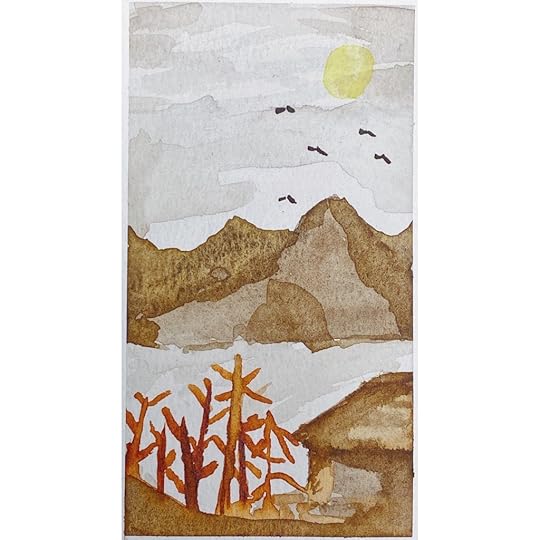3 Tips from a (Month-Old) Artist
You’ve got to start somewhere, Mariella.
That’s what I remind myself when I am trying to paint something and it looks (in my opinion) like something a first-grader would draw. I then remember that, in reality, when it comes to watercolor I am a first-grader.
 the earth sleeping by me
the earth sleeping by meI’ve focused on literature, painting pictures with words, for twenty years of my life. I can write a novel, poem, journal entry, or blog post. I can edit articles for people; I have been rated a 4-star freelancer. I’m accustomed to using words to put images in the minds of my audience.
Creating with color is new to me.
And yet—and yet—
I page through my watercolor sketchbook and see things I cannot believe were created by my hand. That bird looked like a smudge when I was struggling with the wet-on-wet technique. It is stylishly decent when I look with fresh eyes the day after.
Houses are always clumsy in my landscapes, and I wish I could make them more elaborate. However, when I don’t focus on the house, when I look instead at the big picture, I see I’ve begun to understand how this medium works.
If you’ve chosen to take up a hobby and feel pathetic with your attempts, remember we are like babies when we start out. Twenty years of writing to one month of watercolor? The writing will dwarf the paint every time. Whatever it is you have decided to try learning, I ask you join me. We can together be patient with ourselves.
 untitled out of focus
untitled out of focusI see my progress at the piano as an example of how practice and consistency make a difference. Grandma taught me the basics when I was a kid. I did not develop a love for the instrument at that age, but in teaching me the basics, she planted a seed that’s blossoming during my twenty-eighth year.
From this, we can learn three things.
1) If you’re trying to teach someone and it doesn’t work immediately, it doesn’t mean the message will never sink in. I am grieved to think of the frustration Grandma felt when she did not see me approach piano lessons with the enthusiasm she wanted. I regret that my interest in it sprang up after she left.
2) Blue and yellow make green. That note on sheet music, you know the one? That’s Middle C, and it can be found there, and it’s useful for finding your way through a song. The basics, things you learn as a child in first grade, are not without value. These are seeds that blossom into passions when you reach adulthood.
3) Keep calm and carry on: you don’t have to show your first paintings to anyone. You don’t have to play music for them. In the learning phase, it is perfectly fine to keep your progress to yourself. Do not allow your journey to be soured by the urge to impress others.
Consistency and joy—these are the things I’m finding most useful in getting through the process of learning a new art form. If I’m not painting, I’m sketching. If I’m not playing the piano, I’m examining my schedule to find a time when I can be playing it.
 blue things by me
blue things by meDevelop a routine and be consistent. If you can’t set aside an hour to paint, sketch for fifteen minutes. Most of all, find joy in what you’re doing. Don’t let it become a chore—because then you’ll want to quit where you are, in the first grade.
I hope 2022 is treating you kindly so far. Tell me about what you’ve achieved so far!
__ATA.cmd.push(function() { __ATA.initDynamicSlot({ id: 'atatags-26942-61e641d27bf87', location: 120, formFactor: '001', label: { text: 'Advertisements', }, creative: { reportAd: { text: 'Report this ad', }, privacySettings: { text: 'Privacy', } } }); });


